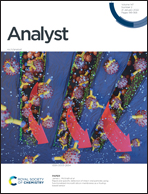Reduced acoustic resonator dimensions improve focusing efficiency of bacteria and submicron particles†
Abstract
In this study, we demonstrate an acoustofluidic device that enables single-file focusing of submicron particles and bacteria using a two-dimensional (2D) acoustic standing wave. The device consists of a 100 μm × 100 μm square channel that supports 2D particle focusing in the channel center at an actuation frequency of 7.39 MHz. This higher actuation frequency compared with conventional bulk acoustic systems enables radiation-force-dominant motion of submicron particles and overcomes the classical size limitation (≈2 μm) of acoustic focusing. We present acoustic radiation force-based focusing of particles with diameters less than 0.5 μm at a flow rate of 12 μL min−1, and 1.33 μm particles at flow rates up to 80 μL min−1. The device focused 0.25 μm particles by the 2D acoustic radiation force while undergoing a channel cross-section centered, single-vortex acoustic streaming. A suspension of bacteria was also investigated to evaluate the biological relevance of the device, which demonstrated the alignment of bacteria in the channel at a flow rate of up to 20 μL min−1. The developed acoustofluidic device can align submicron particles within a narrow flow stream in a highly robust manner, validating its use as a flow-through focusing chamber to perform high-throughput and accurate flow cytometry of submicron objects.



 Please wait while we load your content...
Please wait while we load your content...